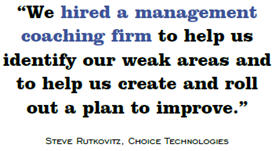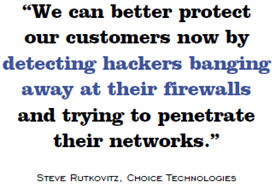What's Delaying Your Transition To Managed Services?
By Jay McCall, Business Solutions Magazine
This break-fix-VAR-turned-MSP shares his 5-year struggle to become an MSP and get 50% of his customers on a fixed-price program.

Many VARs recognize that at some point they are going to have to transition their businesses away from the unpredictable break-fix business model to the more predictable and profitable recurring revenue model of managed services. But, as many as 60% of all channel companies (read: VARs) have yet to make the transition to managed services, according to the latest research from CompTIA. Additionally, a study conducted last year by RMM (remote monitoring and management) vendor, N-able, revealed that out of 1,800 companies that did make the transition to selling managed services, each company was only able to convert 12% of its customers to a fixed-fee managed services program. It’s been evident at many of the trade shows I’ve attended that many VAR-turned-MSPs are not earning the profits they originally expected. With all the data seemingly against selling managed services, it’s easy to understand why so many VARs are hanging on with all their might to the traditional selling model.
Choice Technologies’ story sheds light on the difficulties of selling managed services, and more importantly, how a VAR can make the transition to an MSP. This 32-employee VARturned- MSP is nearly five years into the process and has gone through its share of struggles during that time. Within the past couple of years, however, the MSP has honed its focus on two critical issues that were holding it back from running a profitable managed services practice. Choice Technologies’ CEO Steve Rutkovitz recently shared with me his business strategies, which he believes helped his business get where it is today with 50% of his customers on a fixed-price managed services program and 15% revenue growth projected for 2013.
Stop Business Processes From Running Amok
Like so many channel companies, Choice Technologies has always been good at troubleshooting IT problems. But, technology acumen is rarely the key differentiator between successful and unsuccessful IT solutions providers. “Most MSPs and VARs are good at technology,” says Rutkovitz. “You can’t even stay in business very long if you don’t have that going for yourself.” Where Choice Technologies found that it was lacking was in the category of business process management. “We just didn’t have any consistency in how we handled each sale,” recalls Rutkovitz. “As a result, a number of problems recurred, such as projects running over budget, implementations running behind schedule, underpriced services, and key hardware or software not being ordered.” In essence, Choice Technologies was struggling with all the things that undermine an MSP’s profitability.
In one instance, one of Choice Technologies’ technicians was leaving a customer’s facility and was approached by a customer about an issue with his PC. “The tech said he’d stop back the following day, then forgot all about it, and we found out about the oversight a week later when the customer called complaining about our poor service,” says Rutkovitz.
Rutkovitz believed many of his business struggles came down to getting a deeper understanding of the company’s business processes. “Once we started actively paying attention to how we were doing things, some interesting patterns revealed themselves.” One of the biggest instigators was scope creep. After Choice Technologies presented a customer with a proposal, and the customer accepted, there would inevitably be several additional items the customer would add to the project before or during the implementation, which affected the MSP’s profitability. “A common oversight happened when we upgraded a customer’s server,” recalls Rutkovitz. “For example, a server upgrade might require the customer to also upgrade the network cards in a couple of older PCs from 10/100 Ethernet to Gigabit Ethernet.” This oversight typically led to one of two problems: Either the customer caught the problem and complained, or if the technician caught the oversight during the implementation, he would add-in the updated PC cards and forget to bill the customer. “One of the first process improvements we put in place was a change order process, which required us to switch from manually tracking projects in Excel to using Tigerpaw Software’s professional services automation [PSA] software, which includes project management functionality,” says Rutkovitz. “Now, anytime a customer wants to add something to its original project — such as ordering additional software licenses or workstations — a change order is created in our PSA, and the authorized buyer is sent an authorization form, which must be signed and returned before any updates can be made to the project.”
After putting this automation solution in place, Rutkovitz was surprised at how much smoother the sales and implementation processes worked. Now, if a customer makes a special request from a tech, such as requesting additional software applications, the tech can pull up a change order form and ensure all orders are placed — with the customer’s permission — and all invoicing is adjusted accordingly.
Another step Choice Technologies took to improve its business processes was to create IT management positions, which were designed to assist account managers, project managers, and technicians. “These are detail-oriented employees that are good at handling changes that occur to projects, as well as coordinating communication between customers, sales engineers, and technicians to ensure projects are rolled out on time and on budget,” says Rutkovitz. “All three of our IT managers have bachelor’s degrees — and two of the three have degrees in communications, not technology.”

One area where he’s noticed a big improvement in customer service since creating the IT manager positions is how routine PC maintenance tasks such as periodic disk scanning and defragmenting exercises have become uneventful. “We’ve always performed remote scans after normal business hours, but there’d always be a few customers who worked late that day and would get kicked off their network,” recalls Rutkovitz. “Or, if that didn’t happen, several customers would turn off their computers and we’d have to reschedule our PC maintenance.” Now, the IT managers ensure customers are contacted ahead of time before such activities take place. Additionally, with its new processes in place, an IT manager can pull a list of inventory up front, so the field tech doesn’t need to waste any time looking for cables, networking equipment, and other items prior to going on a service call. It’s also served to reduce unnecessary truck rolls.
“With managed services, there is a lot more communication required to be successful,” says Rutkovitz. “In the past, IT skills were the big differentiator among channel competitors. Going forward, the VARs and MSPs that communicate more effectively will be the big winners.”
Next Steps For MSP Success: Security And Roadmapping
Of course, Choice Technologies’ business process and communications changes didn’t occur without a few hiccups, and the company didn’t figure everything out on its own. “We hired a management coaching firm to help us identify our weak areas and to help us create and roll out a plan to improve,” says Rutkovitz. “With any change, you have to anticipate there will be some resistance. But, the key is to show your employees why you’re making the changes and to keep in regular communication about your intentions.” The MSP’s business changes didn’t take place overnight. Rather, it was a step-by-step process that occurred over a six-month period. During that time Rutkovitz hired four new people, including one technician, two IT managers, and one inside salesperson.
With his business processes and communications dialed in, Rutkovitz looked to apply what he’d learned in his business to help his customers be less reactive with technology buying decisions. “We’re calling this roadmapping because it entails presenting clients with a picture of what their business and IT environment looks like right now and what it could become over the next couple of years,” says Rutkovitz. One of the things that’s been well received with this new approach, according to Rutkovitz, is that it gives customers an opportunity to talk about their businesses and their IT questions — ranging from “Do you think we should invest in Mac computers or PCs?” to “What do you think about the cloud?” Not only does this reduce the questions that were previously addressed to Choice Technologies’ technicians while performing on-site server maintenance or upgrades, but it also enables the MSP to address a topic it believes is very important for its customers: security.

Over the past year, Choice Technologies has developed a process for conducting security audits, which it now does for a fee, as part of its roadmapping consultation process. The next step Rutkovitz and his team are working on is moving away from selling individual security solutions, such as Fortinet firewalls and Vipre antivirus, and instead is offering a bundled network security solution — sold as a service, of course. “We’re calling our new network security offering PerimeterSecure. It does for firewall monitoring what our RMM software does for our servers,” says Rutkovitz. “We can better protect our customers now by detecting hackers banging away at their firewalls and trying to penetrate their networks. We can even automatically check for anomalies in their bandwidth usage, receiving alerts, if, for example, their bandwidth usage jumps 50% in a short period.”
To further improve its network security expertise, Choice Technologies spent a year taking CompTIA security training and was able to earn the CompTIA MSP Partners Trustmark, which Rutkovitz believes carries a lot of weight with his customers and new prospects. “Even though there are currently no official certification requirements for delivering network security solutions and some of our customers aren’t familiar with CompTIA, it’s been a great talking point and allows us to describe the steps we went through to earn this distinction, including 200 hours of training, testing, and documentation of our network security procedures and practices.” In a world of “me too” consultants, Rutkovitz has found this extra step to be a key differentiator when being compared to other VARs and MSPs.
Rutkovitz believes his new bundled offering lines up with the next big channel trend in networking we’ll see this year, and he believes it will usher in a new acronym: MSSP (managed security services provider). “With traditional managed services such as application monitoring and patch updates, you can run into objections,” says Rutkovitz. “With security, however, most SMBs don’t have the in-house expertise, so they’re happy to outsource it. Also, there are lots of proofs available because this topic is covered so much in the mass media.”
The roadmapping approach is being well-received by Choice Technologies’ customers, and it ties in nicely with the business process and communication changes the MSP made to its business over the past couple of years. In that time, Choice Technologies has been growing its revenue at about a 7% clip year-over-year. As the MSP continues honing its road mapping consulting skills and learning to sell network security solutions as a service, 15% revenue growth is becoming very realistic this year.

